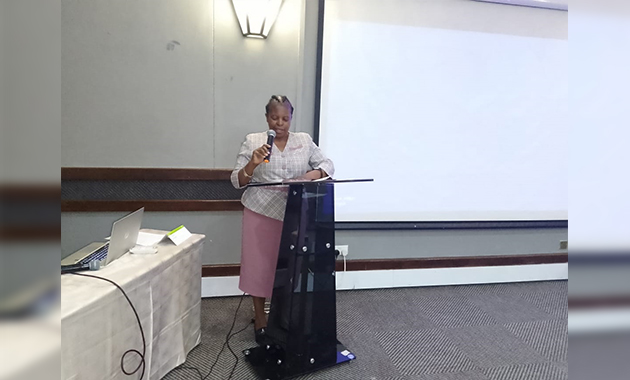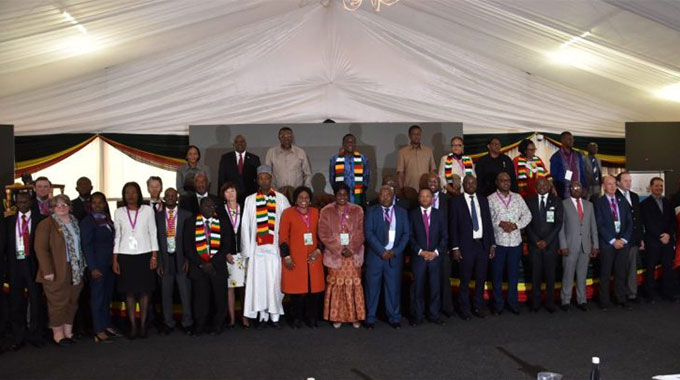‘Goblins’ demand outstrip supply
in urban areas.
To improve their appeal to customers, the bottles are clearly marked with computer printed multi coloured labels identifying each concoction and how it works.
On one of the bottles is an animated strange looking creature that unmistakably represents the “thokoloshi”.
Upon closer look one is surprised with what is on offer there.
There are bottles carrying concoctions and funny looking hand made objects better known as thokoloshis which are now readily available on the streets in Harare, but largely in the country’s eastern town of Mutare.
While in the past the thokoloshis were sold secretly behind “sealed” doors, times have changed are they are now sold in the open.
Surely the world is increasingly getting creepy and whether the thokoloshi’s work or not remains the knowledge of those who have used them.
Wikipedia says in Zulu mythology, Tikoloshe, Tokoloshe or Hili (from the Xhosa word utyreeci ukujamaal) is a dwarf-like water sprite. They are considered a mischievous and evil spirit.
Another explanation is that the Tokoloshe resembles a zombie, poltergeist, or gremlin, created by South African shamans who have been offended by someone.
The tokoloshe may also wander, causing mischief wherever it goes, particularly to schoolchildren.
Other details include its gremlin-like appearance and gouged out eyes. It can also allegedly bring a lot of wealth to the user .
“Some Zulu people (and other southern African tribes) are still superstitious when it comes to things like the supposedly fictional tokoloshe – a hairy creature created by a wizard to harm his enemies (also . . . known to rape women and bite off sleeping people’s toes).”
The Tokoloshe, according to the Zulu shaman Credo Mutwa, has been known to take on many forms.
One form is as described above, but others have portrayed the Tokoloshe as being a bear-like humanoid being.
According to legend, the only way to keep the Tokoloshe away at night is to put a brick beneath each leg of one’s bed.
Although a myriad of hair raising tales have been told of how charms, goblins or rather thokoloshis have broken down families, caused deaths, loss of personal earnings as well as bringing misfortunes to individuals, increasingly people are getting the guts to dine with the devil.
Even when some shudder at the slightest mentioning of goblins (zvikwambo), these individuals are have taken it upon themselves to trade in the underworld wares to eke out a living.
They are prepared to eat from the poisoned bowl only for a few riches, a big house and fleet of cars not from their sweat.
Are these the signs of the changing way of life or are the signs of the end.
Yes thokoloshis are on sale on the streets in downtown Harare, Mbare Msika and on Mutare’s Sakubva high-density suburb.
The market is readily available as the current generation is always in search in money and riches.
“Enterprising vendors” are reportedly “importing” the super “dirty” money making and fortune bringing goblins from neighbouring South Africa.
With Government regularising the mining of diamonds in Chiadzwa, most people who were illegally mining there and had used to the lavish lifestyle of throwing cash all over seem to have found a new avenue of getting back to their old selves.
Those also selling the thokoloshi’s seem to take advantage of the mythical creature to make easy cash out of desperate people.
As such Sakubva Musika has of late become a hive of activity as stone broke individuals who are eager to make quick bucks; loafers who direly need to cast off the unemployment shadow that is strolling them.
These have been joined by the disgruntled neighbours who want to harm the father from the next door; junior workers who want promotion are coming in large numbers to buy goblin of their choice.
The thokoloshi’s are coming in different forms and are sold in different kinds.
They also have varying prescriptive powers.
In Mutare most of the goblins which were on sale were bottled with a frightening weird picture branded on them.
They were written “the strong one” literally meaning that the contents herein were very potent and will bring the desired results in no time.
“The reason why we are selling these things is that they are on demand. They are selling like hot cakes.
“People are buying them for different reasons. Some want to cleanse bad luck, to chase away troublesome goblins, to succeed in business and in life in general.
“You know, people are different and have different problems that need different solutions,” said the trader who preferred anonymity.
Asked whether the goblins really work, the woman answered in the positive.
“Do you want to buy or you are looking for something else.
“It is difficult to explain how it works to someone who does not believe.
“You only know its potency after using cause all you have is what we explain to you. You can try it.”
Another man said the functions of the thokoloshis vary with use and can range as good luck charms to moneymaking machines.
“For kubvisa munyama and chasing away menacing goblins you put this in a small bottle and fill it with water, keep it for a while before one can sprinkle it inside the house, where you sleep, or inside their your car.
“Goblins fear this; they can easily be chased away.
“Tsikamutanda’s and the gauranis often use these in their witch hunting endeavours. Then if you wish to have good luck in everything you do, dilute this with water and bath with it till it is finished.
“However, it takes time for this bottle to finish up and you will never live a life of misery, depression or poverty,” he explains with a wide grin.
Whether his woman’s words were mere marketing gimmick or reality, only God knows.
A big bottle of concoction costs US$11, while the smaller containers cost between US$5 and US$4.
The conversation turned ugly when the woman was asked if she also used the juju she was selling.
“If you don’t want to buy, just leave, I can’t tell you my personal life.
“Wavakuda kubvunzisisa. (You are now unnecessarily inquisitive).
“How can you ask me that? You think those buying these things are foolish?” she said.
In Harare the business is still low, as people do not want to be seen dabbling in the area.
But some healers with spine are now advertising their wares on street corners and locations.
In some suburbs the contrast is more remarkably as at one home there is a sign advertising sell of thokoloshis and a few houses another notifying of a prophet with powers to exorcise this powers.
The Zimbabwe National Healers Association offices are also allegedly advertising good luck goblins with some members openly promoting their use.
The increase in Nigerian and Ghananian movies showing scenes of people making big bucks from goblins and thokoloshis have been blamed for the increase in sell of such objects.
Media reports have indicated that the same line of business of selling thokoloshis is rife in South Africa and Mozambique and other African countries.
In South Africa, the media has jumped to tap on the popularity of the sale of goblins that classifieds section of some newspapers are overwhelmed by adverts of people selling thokoloshis and how they can instantly change lives.
Those in the know have said that the only difference in the business locally and in the neighbouring countries is that in South Africa, the vendors openly reveal to the buyer more details about the thokoloshis.
They provide the buyer with information of what really he is purchasing, how it is used and most importantly, the repercussions – whether positive or negative.
They also give you the proper way of disposing them – which is to return them to the n’anga who gave you at a fee of course.
This to say thank you to goblin for the work that it would have done for you.
The story was originally written by Liberty Dube and appeared in the Manica Post 6-12 May edition.







Comments